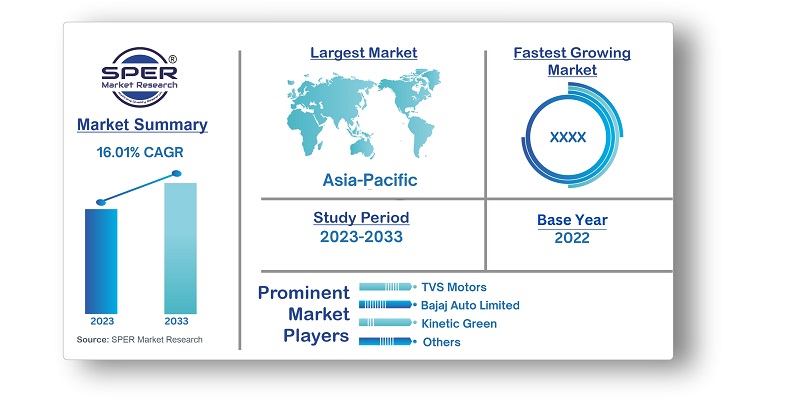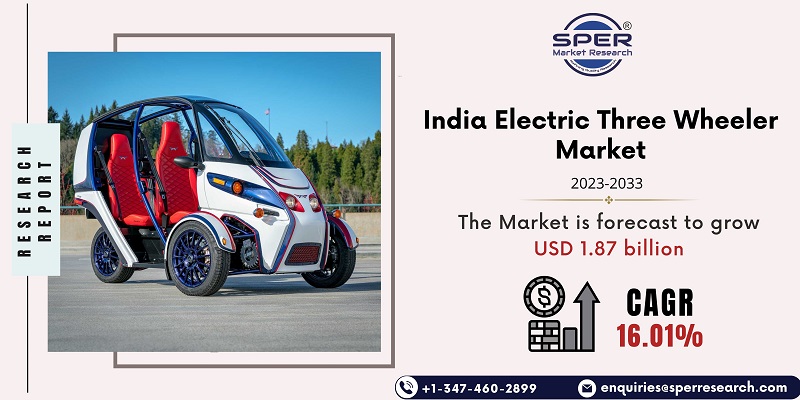
India Electric Three Wheeler Market Growth, Size, Trends, Demand, Revenue and Future Outlook
India Electric Three-Wheeler Market Size- By Vehicle Type, By Battery Type, By Drive Type, By Motor Type, By Power Output, By Voltage Capacity- Regional Outlook, Competitive Strategies, and Segment Forecast to 2033
| Published: Jan-2024 | Report ID: AMIN2429 | Pages: 1 - 103 | Formats*: |
| Category : Automotive & Transportation | |||
- December 2019 - The Indian government unveiled phase II of the FAME India initiative in December 2019, with an emphasis on encouraging the electrification of shared and public transportation. The scheme also seeks to provide incentives for e-buses and e-three-wheelers.


| Report Metric | Details |
| Market size available for years | 2019-2033 |
| Base year considered | 2022 |
| Forecast period | 2023-2033 |
| Segments covered | By Vehicle Type, By Battery Type, By Drive Type, By Motor Type, By Power Output, By Voltage Capacity |
| Regions covered | North India, East India, West and Central India, South India |
| Companies Covered | TVS Motors, Bajaj Auto Limited, Kinetic Green, Piaggio, Lohia Auto (The Lohia Group of Industries), Saera Electric Auto, Altigreen Propulsion Labs, Terra Motors India, and Ceeon India |
- Commercial Goods Transportation Providers
- Passenger Transportation Services
- Government and Municipal Authorities
- Eco-Conscious consumers
- Fleet owners and suppliers
- Charging infrastructure providers
| By Vehicle Type: |
|
| By Battery Type: |
|
| By Drive Type: |
|
| By Motor Type: |
|
| By Voltage Capacity: |
|
- India Electric Three-Wheeler Market Size (FY’2023-FY’2033)
- Overview of the India Electric Three-Wheeler Market
- Segmentation of India Electric Three-Wheeler Market By Vehicle Type (Load Carrier and Passenger Carrier)
- Segmentation of India Electric Three-Wheeler Market By Battery Type (Lithium Ion, Lead acid, and others)
- Segmentation of India Electric Three-Wheeler Market By Drive Type (Hub Type, Chassis Mounted)
- Segmentation of India Electric Three-Wheeler Market By Motor Type (BLDC Motor, PMSM)
- Segmentation of India Electric Three-Wheeler Market By Power Output (<3kW, 3-6 kW, 7-10 kW, >10kW)
- Segmentation of India Electric Three-Wheeler Market By Voltage Capacity (48-59V, 60-72V, 73-96V, Above 96V)
- Statistical Snap of India Electric Three-Wheeler Market
- Expansion Analysis of India Electric Three-Wheeler Market
- Problems and Obstacles in India Electric Three-Wheeler Market
- Competitive Landscape in the India Electric Three-Wheeler Market
- Impact of COVID-19 and Demonetization on India Electric Three-Wheeler Market
- Details on Current Investment in India Electric Three-Wheeler Market
- Competitive Analysis of India Electric Three-Wheeler Market
- Prominent Players in the India Electric Three-Wheeler Market
- SWOT Analysis of India Electric Three-Wheeler Market
- India Electric Three-Wheeler Market Future Outlook and Projections (FY’2023-FY’2033)
- Recommendations from Analyst
1.1. Scope of the report1.2. Market segment analysis
2.1. Research data source2.1.1. Secondary Data2.1.2. Primary Data2.1.3. SPER’s internal database2.1.4. Premium insight from KOL’s2.2. Market size estimation2.2.1. Top-down and Bottom-up approach2.3. Data triangulation
4.1. Driver, Restraint, Opportunity and Challenges Analysis4.1.1. Drivers4.1.2. Restraints4.1.3. Opportunities4.1.4. Challenges4.2. COVID-19 Impacts of the India Electric Three-Wheeler Market
5.1. SWOT Analysis5.1.1. Strengths5.1.2. Weaknesses5.1.3. Opportunities5.1.4. Threats5.2. PESTEL Analysis5.2.1. Political Landscape5.2.2. Economic Landscape5.2.3. Social Landscape5.2.4. Technological Landscape5.2.5. Environmental Landscape5.2.6. Legal Landscape5.3. PORTER’s Five Forces5.3.1. Bargaining power of suppliers5.3.2. Bargaining power of buyers5.3.3. Threat of Substitute5.3.4. Threat of new entrant5.3.5. Competitive rivalry5.4. Heat Map Analysis
6.1. India Electric Three-Wheeler Market Manufacturing Base Distribution, Sales Area, Product Type6.2. Mergers & Acquisitions, Partnerships, Product Launch, and Collaboration in India Electric Three-Wheeler Market
7.1. India Electric Three-Wheeler Market Value Share and Forecast, By Vehicle Type, 2023-20337.2. Load Carrier7.3. Passenger Carrier
8.1. India Electric Three-Wheeler Market Value Share and Forecast, By Battery Type 2023-20338.2. Lead Acid8.3. Lithium Ion
9.1. India Electric Three-Wheeler Market Value Share and Forecast, By Drive Type, 2023-20339.2. Hub Type9.3. Chassis Mounted
10.1. India Electric Three-Wheeler Market Value Share and Forecast, By Motor Type, 2023-203310.2. BLDC Motor10.3. PMSM
11.1. India Electric Three-Wheeler Market Value Share and Forecast, By Voltage Capacity, 2023-203311.2. 48-59V11.3. 60-7211.4. 73-96V11.5. Above 96v
12.1. India Electric Three-Wheeler Market Value Share and Forecast, By Power Output, 2023-203312.2. <3kW12.3. 3-6 kW12.4. 7-10 kW12.5. >10kW
13.1. India Electric Three-Wheeler Market Size and Market Share
14.1. India Electric Three-Wheeler Market Size and Market Share By Vehicle Type (2019-2026)14.2. India Electric Three-Wheeler Market Size and Market Share By Vehicle Type (2027-2033)
15.1. India Electric Three-Wheeler Market Size and Market Share By Battery Type (2019-2026)15.2. India Electric Three-Wheeler Market Size and Market Share By Battery Type (2027-2033)
16.1. India Electric Three-Wheeler Market Size and Market Share By Drive Type (2019-2026)16.2. India Electric Three-Wheeler Market Size and Market Share By Drive Type (2027-2033)
17.1. India Electric Three-Wheeler Market Size and Market Share By Motor Type (2019-2026)17.2. India Electric Three-Wheeler Market Size and Market Share By Motor Type (2027-2033)
18.1. India Electric Three-Wheeler Market Size and Market Share By Power Output (2019-2026)18.2. India Electric Three-Wheeler Market Size and Market Share By Power Output (2027-2033)
19.1. India Electric Three-Wheeler Market Size and Market Share By Voltage Capacity, (2019-2026)19.2. India Electric Three-Wheeler Market Size and Market Share By Voltage Capacity, (2027-2033)
20.1. India Electric Three-Wheeler Market Size and Market Share By Region (2019-2026)20.2. India Electric Three-Wheeler Market Size and Market Share By Region (2027-2033)20.3. India20.4. North India20.5. East India20.6. West and Central India20.7. South India
21.1. Altigreen Propulsion Labs21.1.1. Company details21.1.2. Financial outlook21.1.3. Product summary21.1.4. Recent developments21.2. Bajaj Auto Limited21.2.1. Company details21.2.2. Financial outlook21.2.3. Product summary21.2.4. Recent developments21.3. Ceeon India21.3.1. Company details21.3.2. Financial outlook21.3.3. Product summary21.3.4. Recent developments21.4. Kinetic Green21.4.1. Company details21.4.2. Financial outlook21.4.3. Product summary21.4.4. Recent developments21.5. Lohia Auto (The Lohia Group of Industries)21.5.1. Company details21.5.2. Financial outlook21.5.3. Product summary21.5.4. Recent developments21.6. Mahindra Electric Mobility Limited21.6.1. Company details21.6.2. Financial outlook21.6.3. Product summary21.6.4. Recent developments21.7. Piaggio21.7.1. Company details21.7.2. Financial outlook21.7.3. Product summary21.7.4. Recent developments21.8. Saera Electric Auto21.8.1. Company details21.8.2. Financial outlook21.8.3. Product summary21.8.4. Recent developments21.9. Terra Motors India21.9.1. Company details21.9.2. Financial outlook21.9.3. Product summary21.9.4. Recent developments21.10. TVS Motors21.10.1. Company details21.10.2. Financial outlook21.10.3. Product summary21.10.4. Recent developments21.11. Others
SPER Market Research’s methodology uses great emphasis on primary research to ensure that the market intelligence insights are up to date, reliable and accurate. Primary interviews are done with players involved in each phase of a supply chain to analyze the market forecasting. The secondary research method is used to help you fully understand how the future markets and the spending patterns look likes.
The report is based on in-depth qualitative and quantitative analysis of the Product Market. The quantitative analysis involves the application of various projection and sampling techniques. The qualitative analysis involves primary interviews, surveys, and vendor briefings. The data gathered as a result of these processes are validated through experts opinion. Our research methodology entails an ideal mixture of primary and secondary initiatives.



Frequently Asked Questions About This Report
PLACE AN ORDER
Year End Discount
Sample Report
Pre-Purchase Inquiry
NEED CUSTOMIZATION?
Request CustomizationCALL OR EMAIL US
100% Secure Payment






Related Reports
Our Global Clients
Our data-driven insights have influenced the strategy of 200+ reputed companies across the globe.




















